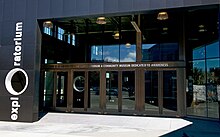Exploratorium

Main entrance to the Exploratorium at Pier 15
|
|
| Established | 1969; relocated in 2013 |
|---|---|
| Location | San Francisco, California, United States |
| Type | Science, art, and human perception |
| Accreditation | AAM, ASTC |
| Visitors | 1,100,000 visits annually |
| Director | Dennis Bartels |
| Public transit access | Green Street and Embarcadero, on the F Market & Wharves streetcar line; several other routes within walking distance |
| Website | www |
The Exploratorium is a public learning laboratory in San Francisco exploring the world through science, art, and human perception. Its mission is to create inquiry-based experiences that transform learning worldwide. It has been described by the New York Times as the most important science museum to have opened since the mid-20th century, an achievement attributed to "the nature of its exhibits, its wide-ranging influence and its sophisticated teacher training program". Characterized as "a mad scientist's penny arcade, a scientific funhouse, and an experimental laboratory all rolled into one", the participatory nature of its exhibits and its self-identification as a center for informal learning has led to it being cited as the prototype for participatory museums around the world.
The Exploratorium was founded by physicist and educator Frank Oppenheimer and opened in 1969 at the Palace of Fine Arts, its home until January 2, 2013. On April 17, 2013, the Exploratorium reopened at Piers 15 and 17 on San Francisco's Embarcadero. The historic interior and exterior of Pier 15 was renovated extensively prior to the move, and is divided into several galleries mainly separated by content, including the physics of seeing and listening (Light and Sound), Human Behavior, Living Systems, Tinkering (including electricity and magnetism), the Outdoor Gallery, and the Bay Observatory Gallery, which focuses on local environment, weather, and landscape.
Since the museum's founding, over 1,000 participatory exhibits have been created, approximately 600 of which are on the floor at any given time. The exhibit-building workshop space is contained within the museum and is open to view. In addition to the public exhibition space, the Exploratorium has been engaged in the professional development of teachers, science education reform, and the promotion of museums as informal education centers since its founding. Since Oppenheimer's death in 1985, the Exploratorium has expanded into other domains, including its 50,000-page website and two iPad apps on sound and color. It has also inspired an international network of participatory museums working to engage the public with general science education. The new Exploratorium building is also working to showcase environmental sustainability efforts as part of its goal to become the largest net-zero museum in the country.
The Exploratorium offers visitors a variety of ways—including exhibits, webcasts, websites and events—to explore and understand the world around them. In 2011, the Exploratorium received the National Science Board 2011 Public Service Science Award for its contributions to public understanding of science and engineering.
...
Wikipedia
